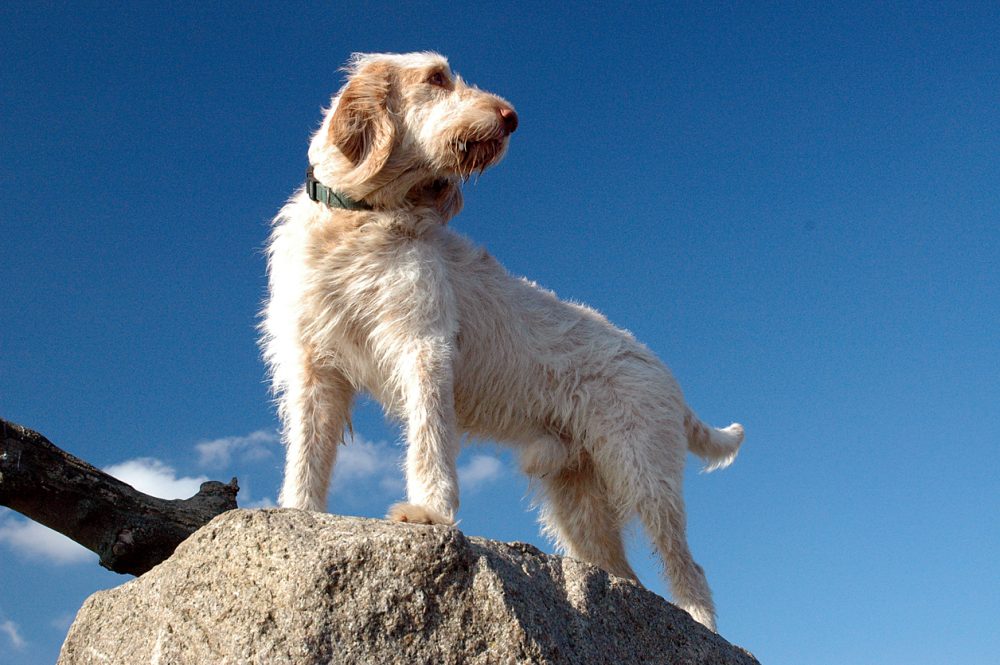
Minimal, moderate, or none at all. We’re talking dewlaps, and you probably woke up today without dewlaps on your mind.
Not us. We sat bolt upright in the middle of the night. Dewlaps! we thought.
Ok, we didn’t. But kidding aside, a show judge couldn’t be blamed if he or she actually did wake up on the morning o a judging assignment with the word on their mind. Dewlaps is a word that appears in most breed standards, and from pendulous and slight, to pronounced and well defined, from minimal and moderate to well divided or none at all, dewlaps is a word that is appears in degrees that are “all over the map.”
A reminder that in layman’s terms, a dewlap is the loose skin hanging around the neck and throat of various breeds, and it has a purpose depending on the breed and its original function. In some breeds that were once war dogs, such as the Neapolitan Mastiff, loose folds protected the dog’s jugular vein in the throat. In scenting breeds, the dewlap helps trap smells; the dog breathes in and out, his breath stirs up dust and fine dirt, and scent molecules are directed towards the nose. In some cold weather breeds such as the Saint Bernard, dewlaps provide a layer of fat to protect the trachea in the winter. Extremely cold air is taken in and warmed to above freezing before it gets to the lungs or else the lung tissue could be damaged. Other breeds fold their forelegs under their dewlap when sleeping which keeps their legs warm and helps prevents damage to the muscles in the event they get cold, but are needed to work right away without first getting warmed up.
Very cool. Pun intended.
Dewslaps, sometimes called “chops” or ‘jowls,” aren’t present in all breeds, and when a dog’s neck doesn’t have excess loose skin, it’s called a ‘clean throat’ or ‘dry throat.’ A few breeds without dewlaps include the Pumi (from the breed standard: “The skin at the throat is tight, dry, and without dewlap“), the Vizsla (Neck strong, smooth and muscular, moderately long, arched and devoid of dewlap), the Sloughi (skin is fine, tight, with no dewlap and the hair is very smooth) and Leonberger (Neck: Muscular, well set on shoulders, blends smoothly into withers, of sufficient length to allow for proud head carriage. No dewlap).
Some breeds, like the Great Pyrenees, have a minimal dewlap, others have a moderate dewlap (from the Tibetan Mastiff standard: The neck is well muscled, moderately arched, sufficient in length to be in balance with the body, and may have moderate dewlap around the throat).
Dewlaps are very prominent in breeds like the Bloodhound and Basset Hound, while in the Dogue de Bordeaux, it is a “well-defined dewlap” that starts at the level of the throat, forms folds down to the chest, and without hanging exaggeratedly.
Otterhounds have a slight dewlap, but the Chinook AKC standard doesn’t mention the word, “dewlap” at all, and describes it as “skin on the neck is pliable but not pendulous.”
We “double dog dare you” to name a breed that has a double dewlap!! Ding ding ding if you said, “Bulldog!” Its standard writes: Wrinkles and Dewlap – The head and face should be covered with heavy wrinkles, and at the throat, from jaw to chest, there should be two loose pendulous folds, forming the dewlap.”
Right about now, some of you might be asking what the difference is between jowls and dewlaps. The short answer is that jowls (which all dogs have to some degree), are loose flaps of skin and lips that hang on either side of a dog’s mouth. Dewlaps hang beneath the lower jaw and throat area, and not all dogs have noticeable dewlaps. Some experts observe that dewlaps were crucial for survival in dogs working in harsh environments or under specific working conditions, and there is a case to be made for that when studying the breeds that have to work through frigid air or sharp bramble and thickets.
In conclusion, while most of us may not have dewlaps on the brain, those to whom we entrust evaluation of our breeds just might. Dewlaps have an impact on breed type, but they also serve as a functional characteristic in various dog breeds. Understanding their role underscores the original purpose of a breed.
Image. The Spinone Italiano also has a double dewlap. Photo by nemoris/iStock
